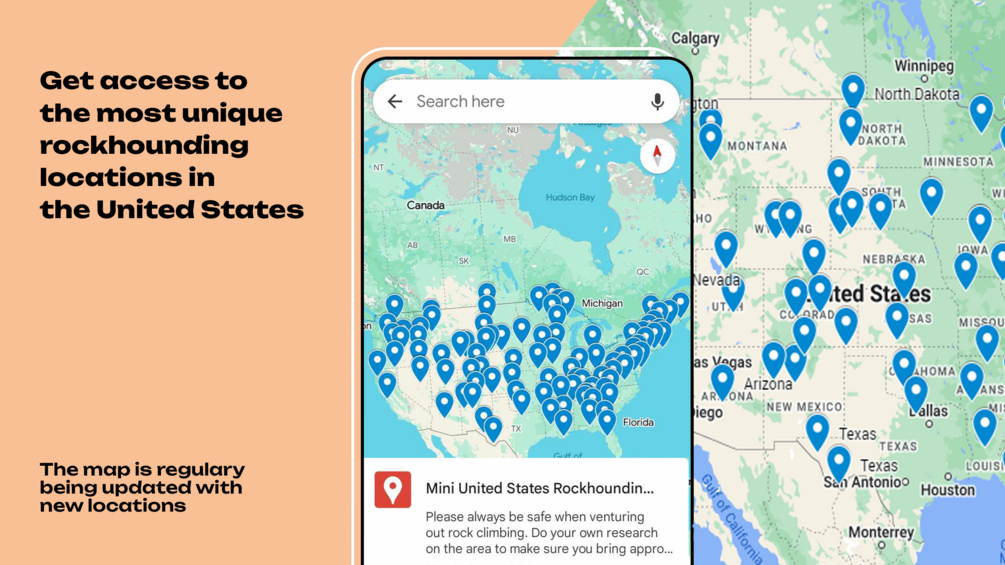Alabama’s rich geological history makes it a hidden gem for rockhounding enthusiasts. Whether you’re a seasoned collector or a curious beginner, the Yellowhammer State offers a treasure trove of minerals, fossils, and crystals.
From the rolling Appalachian foothills to the banks of the Tennessee River, you’ll discover prime spots ripe for exploring. Unearth quartz, garnet, and even the state’s star attraction—star blue quartz. Ready to dig in and find out where these natural wonders are hiding?
Let’s get started on your Alabama rockhounding adventure.
Alabama offers diverse rockhounding opportunities, with sites like Cherokee County for quartz crystals, Jackson County for Paint Rock agates, Coosa County for various quartz types, Talladega County for garnets, and Wilcox County for star blue quartz. Research and respect private property and environment when exploring these sites.
Get our FREE United States Rockhounding Map HERE

Alabama Rockhounding Locations
Embarking on a rockhounding journey in Alabama, you’ll find yourself spoilt for choice with the number of sites to explore. Each location offers unique geological treasures waiting to be unearthed.
Cherokee County stands out as a hotspot for enthusiasts, housing the famous Little River Canyon. Here, the adventurous can search for quartz crystals among the riverbeds and streams. The area’s environment has fostered the growth of these crystals, making it a prime spot for collectors.
In the northeast region, Jackson County lures rockhounds with its plethora of Paint Rock agates, known for their vibrant colors and distinct banding. This semi-precious stone is Alabama’s official state mineral and a must-have for any collection.
Head over to Coosa County where the long-closed Hatchet Creek flows. While the creek’s gold-panning days are over, today rockhounds can uncover various forms of quartz, such as milky, smoky, and even amethyst quartz.
The central part of Alabama is not to be missed, and Talladega County provides another splendid venue for discovering garnets and rutile. Thanks to the county’s geological makeup, these gems can be found sprinkled throughout the region’s soil and streams.
For those looking to add more luster to their collection, Wilcox County is the go-to destination for star blue quartz. This rare and mesmerizing variant of quartz truly embodies the wonder of Alabama’s rockhounding potential.
Remember to check the legality of rockhounding in each area, as some sites may be on private property or have specific regulations. Always obtain permission before you start your search, and be mindful of the environment.
Be prepared to invest time and patience; rockhounding is a rewarding hobby that often reaps the best rewards for those who thoroughly search. Whether you’re a novice or an expert, searching these Alabama locations could result in discoveries that are both valuable and enriching to your collection.
What Gemstones are Found in Alabama?

While on your quest through Alabama, you’ll discover that the state is a treasure trove of gemstones, just waiting to be unearthed. Your journey might lead you to stumble upon Alabama’s state gemstone, star blue quartz, renowned for the star-shaped light reflection it showcases when cut properly.
Alabama’s geology also sets the stage for finding a variety of quartz. You can find clear quartz, the perfect crystal for beginners, or hunt for amethyst, a purple quartz that radiates beauty and is a favorite among seasoned rockhounds. In addition to these, smoky quartz and milky quartz also populate the Alabama soil, each providing a unique twist on the common mineral.
But quartz isn’t the only gemstone you can add to your collection. Below is a quick list of other fascinating gems you might encounter:
- Garnets: These deep red stones are a real find in Talladega County, especially known for the variety called almandine.
- Beryl: Keep an eye out for aquamarine and golden beryl, which are rarer but rewarding finds.
- Tourmaline: Though more elusive, these gems come in a range of colors and are a spectacular sight when found.
Here’s a glance at the gemstones and the counties where you’re likely to find them:
| Gemstone | County Likely Found |
|---|---|
| Star Blue Quartz | Wilcox |
| Amethyst | Coosa |
| Clear Quartz | Cherokee |
| Smoky Quartz | Jackson |
| Milky Quartz | Jackson |
| Garnet | Talladega |
| Beryl | Coosa |
| Tourmaline | Various Locations |
Remember, when you’re searching for these precious stones, it’s imperative to know the specific locations that hold a higher potential for certain gems. Your chances of success increase significantly when you target areas known for particular minerals. Moreover, always ensure you’re equipped with the right tools—a sturdy hammer, chisel, and gloves—to safely extract your found treasures.
What Sedimentary Rocks You Can Find in Alabama?

In your quest for Alabama’s geological treasures, you’ll find that sedimentary rocks are abundant throughout the state. These rocks form from sediment, such as sand or mud, compressing over time and are a testament to the state’s rich ancient marine history.
Key sedimentary rocks to look out for in Alabama include:
- Limestone
- Shale
- Sandstone
Each has its unique characteristics and locations where it’s most commonly found.
Limestone: A Treasure Trove of Fossils
Limestone is prevalent in Alabama, and your exploration can lead you to areas like the Tennessee Valley, where the rock often contains marine fossils from when the area was under an ancient sea. This rock is significant for collectors interested in paleontology and the history of life on Earth.
Shale: Layers of the Earth’s Past
Shale, another sedimentary rock you’ll encounter, is typically found in north Alabama and is known for its fine-grained layers. It’s often located near coal and mineral deposits, hinting at the area’s past geological activity.
Sandstone: A Glimpse into Ancient Environments
Sandstone is common in the Appalachian Highlands of Alabama and provides insights into the environments where it formed, whether in ancient rivers or deserts. Noted for its grains and sometimes colorful patterns, sandstone can also reveal the history of sediment transport and deposition over millions of years.
As you visit different rockhounding sites in Alabama, keeping an eye out for these sedimentary rocks will add depth to your adventure. Remember to research each location beforehand to understand what specific rocks and minerals you might find, as well as the rules and regulations of collecting in that area. With the right knowledge and tools, your rockhounding excursion can uncover the story of Alabama’s geological history—one sedimentary rock at a time.
What Metamorphic Rocks are found in Alabama?
Alabama’s terrain is a treasure trove for those interested in metamorphic rocks. These rocks, which have been transformed from their original state by high pressure and temperature deep within the Earth, are abundant in various locations across the state.
One of the most prominent metamorphic rocks you can find in Alabama is schist. This layered rock often contains glittering minerals and can appear in shades of grey, green, or blue. Schist formations are particularly common in the Eastern Blue Ridge region of the state. When exploring these areas, keep an eye out for muscovite or biotite mica, which can sometimes be seen as shiny flakes within the schist.
Another widely found metamorphic rock in Alabama is marble. Alabama marble, specifically the white marble from Talladega County, is renowned for its purity and has been used in several iconic structures across the United States. In fact, it’s even been dubbed the “finest white marble in the world.”
Slate, a fine-grained metamorphic rock, can also be discovered in Alabama, although it is less common than schist or marble. When looking for slate, you’ll likely encounter it in various shades of grey, and it’s well-known for its ability to split into thin, durable sheets.
For rockhounders, Alabama’s metamorphic rocks offer a fascinating glimpse into the Earth’s dynamic processes. Here’s a succinct table of what you might uncover:
| Metamorphic Rock | Common Colors | Notable Locations |
|---|---|---|
| Schist | Grey, Green | Eastern Blue Ridge region |
| Marble | White | Talladega County |
| Slate | Grey | Varied |
What Igneous Rocks can You Find in Alabama?
While on your quest for Alabama’s geological treasures, igneous rocks may not be as prominent, but they are indeed present and provide a thrilling find for any rockhound. The state is home to a modest collection of these rocks, which formed from the cooling and solidification of magma or lava.
As you explore, look out for pegmatites, coarse-grained igneous rocks that can contain large, collectible crystal formations. Alabama’s pegmatites are often rich in feldspar, mica, and occasionally beryl—the mineral family that includes emeralds and aquamarines. These rocks can be found primarily in the Eastern part of Alabama, specifically within the Piedmont Upland region.
In areas where ancient volcanic activity was present, you might come across basalt—a fine-grained igneous rock. Basalt is often recognized by its dark color and small visible crystals. Although not as widespread as sedimentary rocks in the state, basalt deposits provide a glimpse into Alabama’s fiery geological past.
Discovering igneous rocks such as pegmatite and basalt may require visiting specific localities. Here are spots where you stand a good chance to spot these geological wonders:
- Coosa County: Known for pegmatites that yield sizeable feldspar and mica specimens.
- Clay County: Offers opportunities to find pegmatite that contains beryl.
- Randolph County: Sporadic basalt outcrops can be explored here.
Remember to equip yourself with a geologist’s hammer and eye protection when searching for igneous rocks, as breaking into fresh rock may be necessary to uncover the best specimens. And always respect property boundaries and seek permission if you’re venturing onto private land.
Your rockhounding journey in Alabama isn’t limited to the beauties of the surface—you’ll find that even beneath the soil lies a world of crystalline intrigue waiting to be uncovered. As you delve into different regions of the state, each igneous rock discovery will add another fascinating layer to your collection and deepen your understanding of Alabama’s rich geological tapestry.
Panning for Gold in Alabama
When you’re on the hunt for more than just colorful gemstones and stately rocks, Alabama offers a sparkling opportunity for you to get hands-on with gold panning. Gold mining in Alabama began in the early 1830s, and it’s a tradition that continues to this day, mainly concentrated within the state’s Gold Belt. As you’d expect, this is an area where prospectors once flocked during the Alabama Gold Rush. Nowadays, amateur geologists and enthusiastic treasure seekers can explore several creeks and rivers, which still hold fine flour gold and even rare nuggets.
Your first stop in the Gold Belt should be the Tallapoosa River, a historically significant gold-bearing river. As you pan the waters, keep your eyes peeled for the yellow glimmer of gold mixed among the river’s sediment.
- Key Locations for Gold Panning:
- Hog Mountain
- Chulafinnee
- Pinetucky
- Goldville
In these areas, you’ll find placer deposits— a miner’s term for gold that’s eroded from rock formations and settled in creek beds, easily scoopable with your trusty pan. Ensure you’re panning in public areas or have secured permission to prospect on private land.
Prospecting Tools you’ll need include a sturdy pan, a shovel, and sieves. Consider carrying a metal detector to help identify areas with higher mineral content. When you’re at the water, remember to look for gold in the natural riffles of streams where heavier materials tend to settle. It’s wise to do some research on effective panning techniques to maximize your chances of striking it lucky.
Rocks and Minerals Found in Alabama
As you continue your rockhounding journey through Alabama, you’ll find a staggering variety of rocks and minerals at your fingertips. The state is a treasure trove not only for its star blue quartz but for many lesser-known finds as well. Scattered throughout Alabama are minerals such as beryl, known for its green varieties like emerald, and mica which often appears in sheets or flakes in metamorphic rocks.
Beyond the sparkle of gemstones, fossilized remains persist in Alabama’s geological record. Trilobite fossils and ancient sea life like brachiopods are particularly sought after by collectors and can be commonly found in some of the state’s sedimentary formations. Here’s a brief look at some of the most coveted rocks and minerals you might encounter:
- Star Blue Quartz: The state gemstone, often found in Coosa County.
- Amethyst: Ranging from light to deep purple, typically located in the northern regions.
- Milky Quartz: A classic collectible, milky due to inclusions.
- Beryl: Present in various colors, including the prized emerald.
- Mica: Often discovered within the state’s metamorphic rock.
Alabama’s geological layers also include impressive crystal formations. Quartz crystals are widespread, echoing their crystalline calls from within the older rocks found across the state. Geodes, while rarer, can still be unearthed, particularly in areas with limestone deposits. Hunting for these can be an exhilarating experience as the unassuming exterior of geodes gives way to the sparkling interior only once cracked open.
The allure of Alabama’s geology extends to its metamorphic and igneous offerings, where granite and schist prevail. In the east-central parts of the state, you’ll encounter the complex history recorded in these rocks. For the intrepid rockhound, the diversity of Alabama’s geology is a never-ending source of discovery.
Considering the range of rocks and gems available, it’s crucial to pack accordingly. A sturdy hammer, chisel, and gloves are the basics, but don’t overlook the need for safety goggles. Remember, responsible rockhounding means respecting private property and securing permissions where necessary, ensuring that you can continue to enjoy this rewarding hobby for years to come.
Where Can I Find Fossils in Alabama?
Discovering fossils in Alabama can be as exhilarating as finding gemstones. This state is ripe with prehistoric remains due to its vast, ancient seas. Fossil hunting locations are scattered throughout, offering a glimpse into the Paleozoic and Mesozoic eras.
In the northern region, you’re likely to uncover trilobites and brachiopods in the chert gravels of Lacefield’s Farm. The site has become widely recognized among paleontology enthusiasts for its accessibility and yield. Just ensure you have permission to explore, as it’s private property.
Head over to the banks of the Cahaba River. Here, marine fossils are abundant, particularly invertebrates like gastropods and bivalves. Known for its biodiversity, the river is not just for fossil hunters but also for nature lovers.
Franklin County offers unique opportunities where remnants of ancient life are embedded in roadside outcrops. Always be cautious on active roadways, but don’t miss the chance to find crinoid stems and corals that date back millions of years.
For those near Montgomery, the Montgomery County Pits are a haven for fossil seekers. These former quarry sites reveal shark teeth and echinoids that the Gulf’s waters once sheltered. Remember, safety comes first, so wear appropriate gear and be aware of your surroundings.
Tips for Successful Fossil Hunting:
- Obtaining permission is a must when accessing private lands.
- Carry a geological hammer, chisels, and brushes for careful extraction.
- A field guide to Alabama fossils will help identify and understand your finds.
- Record the location and context of your discoveries for scientific value.
Bring your curiosity and patience to these fossil-rich locales in Alabama. Whether you’re a seasoned collector or a curious novice, the thrill of unearthing a piece of Earth’s ancient past awaits. As you plan your expedition, keep in mind the rich mineral deposits you’ve learned about earlier—fossils can often be found in these same areas, making your rockhounding adventure doubly rewarding.
Alabama Rockhounding Laws & Regulations
While exploring Alabama for geological treasures, you need to be aware of the guidelines and restrictions in place. Rockhounding, similar to other collecting hobbies, is governed by state laws as well as local ordinances.
Public Lands are typically more regulated. To rockhound in places like national forests, you’ll require a permit for any kind of collection. Be sure to check with the local forest service office to understand the specific rules that apply. These regulations are in place to protect the environment and ensure that rockhounding remains a sustainable activity.
On the other hand, when you are on Private Properties, obtaining permission from the landowner is crucial before you start your search. Trespassing can lead to hefty fines or more serious legal trouble. Additionally, property owners may provide useful information about where to find the best specimens on their land.
Alabama also endorses the American Federation of Mineralogical Societies’ Code of Ethics. This set of guidelines encourages responsible collecting, respect for property, and consideration for natural habitats. As a rockhound, you’re expected to:
- Obtain permission for access and collection
- Utilize tools that prevent unnecessary damage to the land
- Dispose of waste properly
- Respect restricted areas and historical sites
- Always secure relevant permits for public lands
- Seek explicit permission from private landowners
- Adhere to the AFMS Code of Ethics
It must be noted that certain areas, such as archaeological sites and places with endangered species, are off-limits to collecting. Fossil Collecting often falls under different rules, so make sure to research or inquire about regulations if you’re specifically interested in paleontology.
Keeping up-to-date with the latest information on state legislation will ensure your rockhounding adventures are both enjoyable and compliant with Alabama’s legal framework. Remember, regulations can change, and it’s your responsibility to stay informed.
Rockhounding Tips for Beginners in Alabama
Gearing Up: Essential Tools for Rockhounding
Before you head out on your Alabama rockhounding adventure, you’ll need to ensure you’re properly geared up. Essential tools can make or break your experience, so it’s crucial to come prepared. A rock hammer, often the rockhound’s tool of choice, should be at the top of your list. This specialized hammer is a lifeline for chipping away at rock formations and prying out mineral samples.
Next, you’ll need a good pair of gloves. The terrain in certain areas can be rough, and gloves will protect your hands from sharp edges. You won’t regret packing safety goggles too, as they provide essential eye protection when you’re splitting rocks. Other key items include:
- A sturdy backpack or bucket to carry your finds
- A chisel set for detailed work
- A magnifying glass to examine your treasures
- Adequate water and a first aid kit for longer excursions
Remember, the tools you carry not only aid in discovering gems but also in ensuring your finds are well-preserved.
Safety Tips While Rockhounding
Rockhounding can be a safe and enjoyable hobby, provided you follow some basic safety guidelines. Always let someone know where you’re going, especially if you’re heading to remote areas. Alabama’s weather can be unpredictable, so check the forecast beforehand and dress appropriately. Wear sturdy boots with good grip to navigate slippery or uneven surfaces with ease.
Stay hydrated and pack enough food, especially during the hot and humid summer months. Watch out for local wildlife and be prepared to encounter insects and snakes, common in Alabama’s great outdoors. In case of an emergency, ensure your cell phone is fully charged, and you have a map or GPS device handy.
Legal Guidelines for Rockhounding Enthusiasts
When embarking on your rockhounding journey in Alabama, staying informed about the legal guidelines is crucial. Start by obtaining proper permits if required, particularly when collecting on public lands. Know that certain areas are off-limits for rockhounding such as state parks, national monuments, and historical sites.
Private lands require explicit permission from the property owners before you start scouring their land for geological treasures. It’s also worth noting that collection of vertebrate fossils and artifacts is typically prohibited without special authorization. Remember, the laws are in place to protect both geological and cultural heritage, so adherence is not just a legal obligation but a moral one as well. Keep up to date with any changes in the legislation that may affect where and what you can collect. Doing so ensures that you enjoy rockhounding within the bounds of the law and with full respect for the environment.
Conclusion: Alabama Rockhounding Locations
Venturing into Alabama’s varied landscapes, you’re well-equipped for a successful rockhounding adventure.
With your essential tools in hand and safety measures in place, you’re ready to unearth the geological treasures that await. Remember to respect the land and its laws, ensuring that your explorations contribute to the preservation of Alabama’s rich natural history. Whether it’s discovering fossils along riverbanks or unearthing minerals in old pits, the thrill of the find is just a stone’s throw away. So grab your gear, follow the guidelines, and embrace the excitement of rockhounding in Alabama. Your next remarkable discovery is out there, and it’s yours to find.
Happy hunting!


![Virginia Rockhounding Sites in [year]: Guide & Finds](https://observationhobbies.com/wp-content/uploads/2024/01/GLmeOzdUxOYuYKnhLJv6g-768x439.jpg)



![Utah Rockhounding Sites in [year]: What to Find & Locations](https://observationhobbies.com/wp-content/uploads/2024/01/sQHkb_e4j6uFynupspziY-768x439.jpg)
